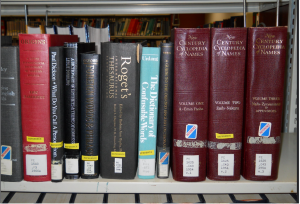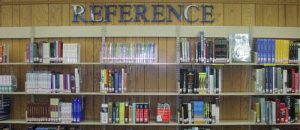Eliminating reference sections in school library learning commons isn’t just something to ponder, it is an event that is in the past; meaning, in my SLLC, it has already happened!!!
I work in an elementary school, and I have not seen a designated reference section on the shelves for years. If you are looking for a set of encyclopedias, or a dictionary, you will not be able to find any physical copies in my school’s LLC. The same premise holds in the children’s section of public libraries. Watch Butler Public Library’s video of Librarian Ms. Tiffany explaining about her LLC’s reference section, the difference between reference materials and non-fiction materials, and where these sections are located.
Given how the trend toward reference sections in elementary LLC’s are, is there still a need to keep these types of resources on the shelves in a School Library Learning Commons? I believe there is, and it begins with developing a reference collection plan.
First, to review, a reference section of a Library Learning Commons houses reference texts that do not circulate. They are marked by a “R” or “Reference” sticker on the spine. These books are used to support a school’s information literacy goals. When students and teachers need to find quick facts, they should use texts found on the shelves of the Reference Section. See picture below.
 (Flickr, 2024)
(Flickr, 2024)
Typically, texts such as sets of encyclopedias, atlases, and dictionaries, are examples of these types of materials. The image below taken from Polson High School’s LLC of their Reference Collection shelves is a perfect example of a reference section of books found in a school that do not circulate.
 (Polson High School, 2024).
(Polson High School, 2024).
As Riedling makes note of in her work, the “… reference collection occupies at least two places in the library – on bookshelves in a separate section and on the school library Web page” (Ann Marlow Riedling, 2013). In “Achieving Information Literacy: Standards for School Library Programs in Canada”, Asselin, et al. state that standards for a school library “…collection is to reflect an appropriate balance of print, non-print, and electronic and digital resources. The library catalogue, which includes records for all resources in the school, is to be accessible through remote databases or websites” (Canadian Association for School Libraries, 2006). Creating a Reference Collection Development Plan would ensure that the standards made above are achieved and upheld to best serve the needs of the school community. As made note of by Cynthia Houston in her presentation on Reinventing Your Reference Collection, relying on professional organizations such as the ALA, and in my case, the CSLA Guidelines is a good place to begin as the guidelines serve TL’s in creating balanced collections of print and digital resources (Houston, 2016).
As mentioned before, physical sets of encyclopedias such as World Book and Encyclopedia Britannica are no longer housed in the SLLC’s physical collection in most elementary schools. Non-fiction, informational books are acquired and housed in the physical collection but are interspersed throughout the non-fiction shelves and circulate. Most elementary schools have done this over the years and have relied on digital platforms to support the inquiry needs of the school community. The benefit to removing encyclopedia sets is the space on the shelves that has become available for other works, or for other Learning Commons initiatives such as maker spaces.
The plan for access to reference material in my school district, along with many others, is to access reference collections through the BC Digital Classroom operated by FOCUSED BC. FOCUSED BC grants students and teachers access to many digital platforms that support the BC Curriculum for grades K-12. World Book, which is offered in different categories by grade level, provides students a digital means to explore these resources for their inquiries. Overall, these platforms are accessible to students provided that both teachers and the Teacher-Librarian demonstrate to students how to access and use these research tools. However, this can only happen with access to technology such as tablets, laptop computers, and desktop computers. My school has all of these, but have only 2 class sets of portable technology, and one class set of desktop computers all of which are accessed by teachers on a sign-out basis. Most students in my school do have access to web-based technological tools at home. This means that 7 day/week access is possible, but does this give students the best exposure and experience with reference collections?
 (Images).
(Images).
There is good reason to keep some of these resources housed in SLLC’s at the elementary level. Many companies such as National Geographic and Usborne publish “encyclopedias” on special topics which provide students with immediate access to information. Atlases are very useful for young students to access when learning about the geography of their home and the planet they occupy.

Texts such as these can and should be in the SLLC’s physical collection shelved within the non-fiction section as they contain vivid, eye-catching graphics, and teach students how to read a non-fiction text such as captions, glossaries, indexes, table of contents, and side bars. Young children, K-4 in particular, can use technology, but find it difficult to navigate digital encyclopedias and become easily frustrated. When this happens the object of exposing students to the world of information and wonder becomes lost.
Reference books containing factual content are high interest books for younger students and are frequently requested in the SLLC and classrooms. Young students still love the tactile experience of holding a book in their hands and reading the pages as they discover facts about a topic. These books invite young learners to engage with the images and text and make meaning from the ideas illustrated in these works.
References
Ann Marlow Riedling, L. S. (2013). Reference Skills for the School Librarian – Tools and Tips (3rd ed.). Santa Barbara, CA: Linworth.
Canadian Association for School Libraries. (2006). Achieving Information Literacy – Standards for School Library Programs in Canada. (M. Asselin, J. L. Branch, & D. Oberg, Eds.) Ottawa, ON, Canada. Retrieved from http://accessola2.com/SLIC-Site/slic/ail110217.pdf
Flickr. (2024, January 29). Reference Books. Retrieved from file:///C:/Users/linet/OneDrive/Documents/Linette/Library/LIBE%20467/Reference%20Books%20%20_%20Flickr.mhtml
Houston, C. R. (2016). Reinventing Your Reference Collection. Bowling Green, KY, USA. Retrieved 01 29, 2024, from https://www.canadianschoollibraries.ca/program-guidelines/
Images, B. S. (n.d.). Question Mark.
Polson High School. (2024, January 29). Polson High School Library General Reference Collections. Retrieved from Polson High School: https://www.polson.k12.mt.us/polson-high-school/students/library/general-reference-collections

Hello Linette!
Great blog! I totally agree on keeping printed formats of reference materials for students to access in the learning commons. They are still valuable for encouraging childrent to read more and to learn how to use a non-fiction text and reference book for information gathering. I like the video you provided too. Very informative
Claudia
Hi Linette,
I agree with what you said regading young readers and reference books – they love them. And when they check them out, they are excited about what the pages contain. Those Nat Geo readers are so popular with the primary students. I have always encouraged K and 1 to find one fiction book and 1 non-fiction book to take out. It is a great way for them to explore the reference section by reading the shelf labels and to become familiar with various text features by sight so that when they get to grade 2, they understand how reference resources are organized.
Hi Linette,
I completely agree with you that K-4 students really benefit from having access to print reference materials, but that it is equally important that these materials are allowed to circulate. Young students especially need to be able to spend time with a text on their own terms, reading and rereading in order to make meaning. Prior to your post I was not familiar with the National Geographic and Usbourne subject specific encyclopedias and atlases, but they look like fabulous resources that I will definitely be putting on the Wishlist for our library.
It was interesting for me to read about the elementary perspective. I was under the impression that we at the secondary level were the ones using primarily digital resources and that our elementary colleagues were more inclined to be using print sources for building the foundational skills. I am now curious if this is the norm in different districts.
Hi Erin,
I can’t answer your inquiry about use of digital references in elementary education across districts in BC, but I do know the K-12 digital classroom was curated as a means for schools to provide greater access to quality reference resources that can be updated frequently. It is a useful resource tool, but younger students still do better at finding information with print resources.